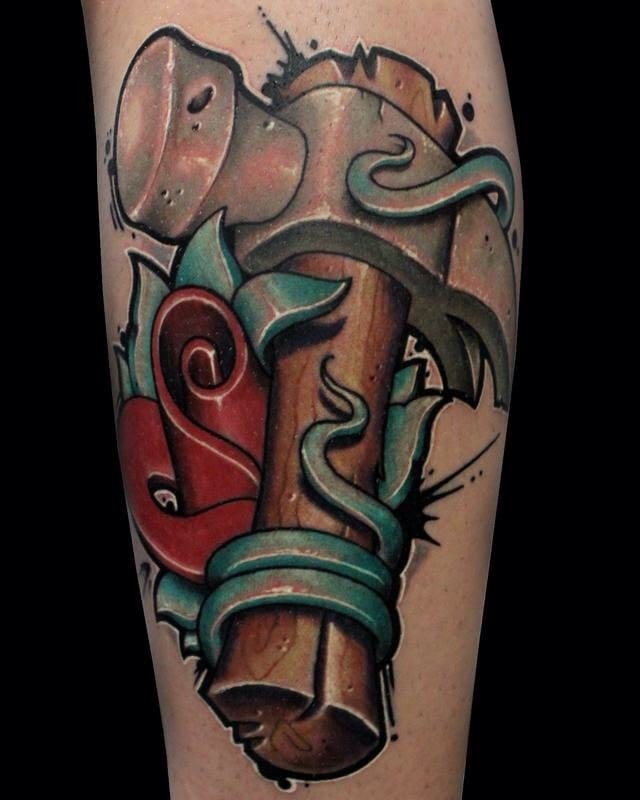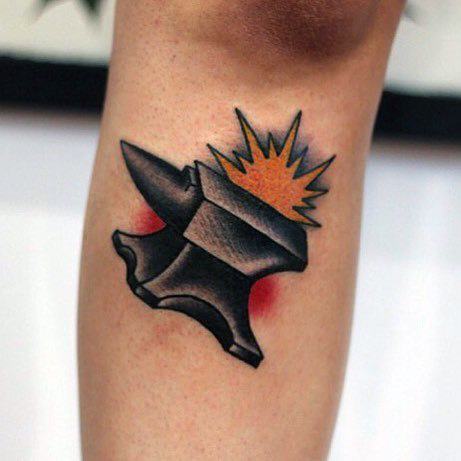


With it in this position, it is a shorter distance to bring the hammer back up to the appropriate striking position, over say, letting one’s hammer and arm rest at one’s side while the piece is examined.

In the former case, resting the hammer on the anvil next to the piece is simply a convenient place to rest it. In reality, they are not actually tapping the anvil for any real purpose other than to simply either rest their arm while they quickly examine the results of the last few strikes or to simply keep their rhythm while they examine the piece. Further, the very brief contact between the hammer and the anvil isn’t going to transfer very much heat, even if the anvil is quite cold. Warm hammers and warm anvils are actually what they want, because it keeps the hot metal they’re working with from cooling down as quickly, so it requires less heating while shaping, which saves time. You may have heard that they do this to cool the hammer down by having it come in contact with the anvil, but this is the opposite of what they’d want to do. On a related not, if you’ve ever watched a smith work, you’ve probably noticed many of them will strike whatever they’re working on a few times, then follow it up by lightly tapping the anvil’s step or face a couple times. So, basically, the pritchel hole is a round version of the hardy hole. The pritchel hole can also be used for holding tools.

The hardy hole is a square hole through the anvil that allows you to secure various tools in the anvil.Unlike the step, it often features slightly rounded edges so that the edges don’t cut into the metal being pounded on the face. It also contains the hardy hole and the pritchel hole. The face is the main large flat slab where most of the hammering takes place.However, frequent use of the step for this purpose can also damage it, so the use of tools attached to the anvil for cutting is often preferred for non-hobbyists. This is often used as the cutting area, using the edge of the step to “cut” a piece while hammering it. The step is the flat area next to the horn, just below the face.Some anvils also come with multiple horns, of differing shapes and sizes. This allows the smith to hammer different curves into the piece they are working on, with the precise curve depending on how and what part of the horn they hold the piece on while they hammer it. The horn is the “front” end of the anvil which is curved.The primary use of these various elements is as follows: While the length and overall size of the various elements can vary from anvil to anvil, the key features of the “standard” design are typically a horn, a step, a face, a hardy hole, and a pritchel hole. Over the centuries, the common shape of the anvil has evolved from a simple slab to the shape most of us associate with an anvil today, namely the “London Pattern”, which became common in the 1800s. The first metal anvils were made of bronze, then wrought iron, and, finally, steel, which is the material of choice today for anvils, though cast iron is also used in low-end anvils (cast iron is quite brittle for this particular use and absorbs more of the hammer blow’s energy than steel does, so it is not preferred). These primitive objects used for anvils were typically made of stone, often just a slab of rock. sometimes tap the anvil after a few strikes on the object they’re working on.Īnvil shape has evolved greatly since the earliest anvil-like objects. Today I found out why anvils are shaped the way they are and why blacksmith/farriers/etc.


 0 kommentar(er)
0 kommentar(er)
